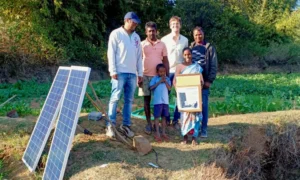‘Silicon Valley of India is sinking’. ‘Bentley cars and SUVs submerged’. ‘Brand Bangalore hurt’. ‘Floods fury in Bengaluru’…
Agitated and loud voices of news anchors have filled living rooms as they scream out these headlines, from their studios. And their high pitched commentary has been accompanied by visuals of flooded streets in Bengaluru, where expensive Bentley cars and SUVs float in the floodwaters at the partially submerged post localities in the IT city.
There were shots of the Arkavathi river (yes, a river flows through Bengaluru) and an overflowing Bellandur Lake (made famous for the toxic froth that floats on its surface), that played on loop.
This week, Bengaluru received extremely heavy rainfall that flooded various areas in the city extensively. Social media feed and television screens, non stop, showed the extent of the damages due to the floods.
The Outer Ring Road Companies Association, which represents all major IT and banking companies on the Outer Ring Road stretch of the metropolis, has pegged its losses at Rs 225 crore! And these are just preliminary estimates.
Media, the fourth pillar of democracy, whose job is to report and inform the people, and also to put pressure on the government and authorities to address issues affecting citizens of the country, has left no stone unturned (and rightly so) in reporting on Bengaluru floods, its causes and losses, and mitigation measures needed both in the short and long terms.

The matter needs close scrutiny especially in a changing climate when rainfall patterns are becoming erratic and urban water bodies are fast disappearing due to legal and illegal encroachments.
Meanwhile, away from the hullabaloo of the Silicon Valley of India, in the country’s rural areas, there have been devastating losses too. Were you aware that since June this year, millions of farmers in the country have watched helplessly as drought conditions have led to huge losses, as their kharif crops, mainly paddy, has wilted due to less rainfall?
In all likelihood, you may not know. News channels have not really felt the need to report on the prevailing drought conditions in some key paddy growing states in the country in Uttar Pradesh, Bihar, Jharkhand, and West Bengal. These states received deficient monsoon rainfall because of which hundreds of thousand paddy farmers either could not sow paddy this year, or lost the paddy saplings altogether.
Rainfed agriculture occupies about 51 per cent of the country’s net sown area and accounts for nearly 40 per cent of the total food production.
Paddy is the main kharif crop of the country and rice a staple food grain that feeds a large population of our country.

The ramifications of low production of paddy in India can potentially affect the global supply of rice as well. Photo: Virendra Singh.
Rice (along with wheat) is an integral part of the country’s public distribution system (PDS), and is offered to beneficiaries under the National Food Security Act, 2013, which covers 75 per cent of rural population and 50 per cent of urban population.
While we have LIVE panel discussions on what led to floods in Bengaluru, there has not been a whisper of news about the paddy farmers in Bihar, or the farm labourers in Jharkhand who have lost their means of livelihood. Many of them have had to migrate from their villages in search of work to feed their families.
Surely, failed monsoons and failed paddy crops deserve as much media coverage as SUVs going under. After all, a failed crop is something each of us has to worry about. We need food to survive!
Why is ‘mainstream’ media so oblivious of the issues in rural India where two-thirds of the citizens live? Why is it that the villages of the country make it to the national news only when a large number of farmers die by suicide, or rural women descend into dry dug wells to fill a small pot of water, or a gruesome gang-rape is reported from there?
For a decade, Gaon Connection, India’s biggest rural media platform, has been trying to strengthen the voice of rural India so that the rural citizens can be heard in the power corridors of the country. Through text and video stories, and now Gaon Radio, Gaon Connection is bridging the gap that exists between urban and rural India.
Since mid-July, reporters and community journalists of Gaon Connection have travelled across Uttar Pradesh, Bihar, Jharkhand and West Bengal, highlighting the plight of paddy farmers and warning of a possible drop in paddy production. It should worry each one of us as it is a matter of our food basket.
The country has already had lower wheat production this year due to the early arrival of heatwaves. And now, the Indian government has also put curbs on rice exports!
India is the world’s largest exporter of rice with a share of 40%. The Indian govt has announced curbs on rice exports and imposed 20% export tax on non-basmati & non-parboiled rice exports.
On Sept 3, @GaonConnection had reported on a possible ban
https://t.co/mjSzJMYRR2 pic.twitter.com/eM6cx2kjZr
— Gaon Connection English (@GaonConnectionE) September 8, 2022
Being an environment journalist myself, I understand the importance of reporting on urban floods, like the ones that hit Bengaluru this week. However, we, in the media, do a disservice to the nation, when we fail to give equal weightage to stories from rural India.
Rural India feeds the nation, provides varied natural resources, and also human labour that propels the growth of the country.
Ten years ago, in 2012, when Neelesh Misra, a journalist and storyteller, started Gaon Connection, he wanted to promote impactful rural journalism. We remain committed to that cause. To us, farmers and food grains will always be bigger news than SUVs.


















